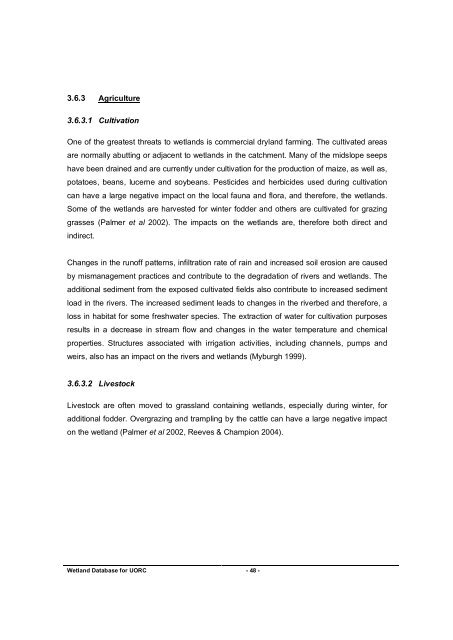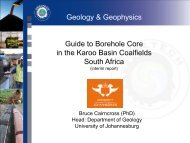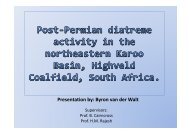coaltech upper olifants river catchment wetland inventory ...
coaltech upper olifants river catchment wetland inventory ...
coaltech upper olifants river catchment wetland inventory ...
Create successful ePaper yourself
Turn your PDF publications into a flip-book with our unique Google optimized e-Paper software.
3.6.3 Agriculture<br />
3.6.3.1 Cultivation<br />
One of the greatest threats to <strong>wetland</strong>s is commercial dryland farming. The cultivated areas<br />
are normally abutting or adjacent to <strong>wetland</strong>s in the <strong>catchment</strong>. Many of the midslope seeps<br />
have been drained and are currently under cultivation for the production of maize, as well as,<br />
potatoes, beans, lucerne and soybeans. Pesticides and herbicides used during cultivation<br />
can have a large negative impact on the local fauna and flora, and therefore, the <strong>wetland</strong>s.<br />
Some of the <strong>wetland</strong>s are harvested for winter fodder and others are cultivated for grazing<br />
grasses (Palmer et al 2002). The impacts on the <strong>wetland</strong>s are, therefore both direct and<br />
indirect.<br />
Changes in the runoff patterns, infiltration rate of rain and increased soil erosion are caused<br />
by mismanagement practices and contribute to the degradation of <strong>river</strong>s and <strong>wetland</strong>s. The<br />
additional sediment from the exposed cultivated fields also contribute to increased sediment<br />
load in the <strong>river</strong>s. The increased sediment leads to changes in the <strong>river</strong>bed and therefore, a<br />
loss in habitat for some freshwater species. The extraction of water for cultivation purposes<br />
results in a decrease in stream flow and changes in the water temperature and chemical<br />
properties. Structures associated with irrigation activities, including channels, pumps and<br />
weirs, also has an impact on the <strong>river</strong>s and <strong>wetland</strong>s (Myburgh 1999).<br />
3.6.3.2 Livestock<br />
Livestock are often moved to grassland containing <strong>wetland</strong>s, especially during winter, for<br />
additional fodder. Overgrazing and trampling by the cattle can have a large negative impact<br />
on the <strong>wetland</strong> (Palmer et al 2002, Reeves & Champion 2004).<br />
Wetland Database for UORC - 48 -




